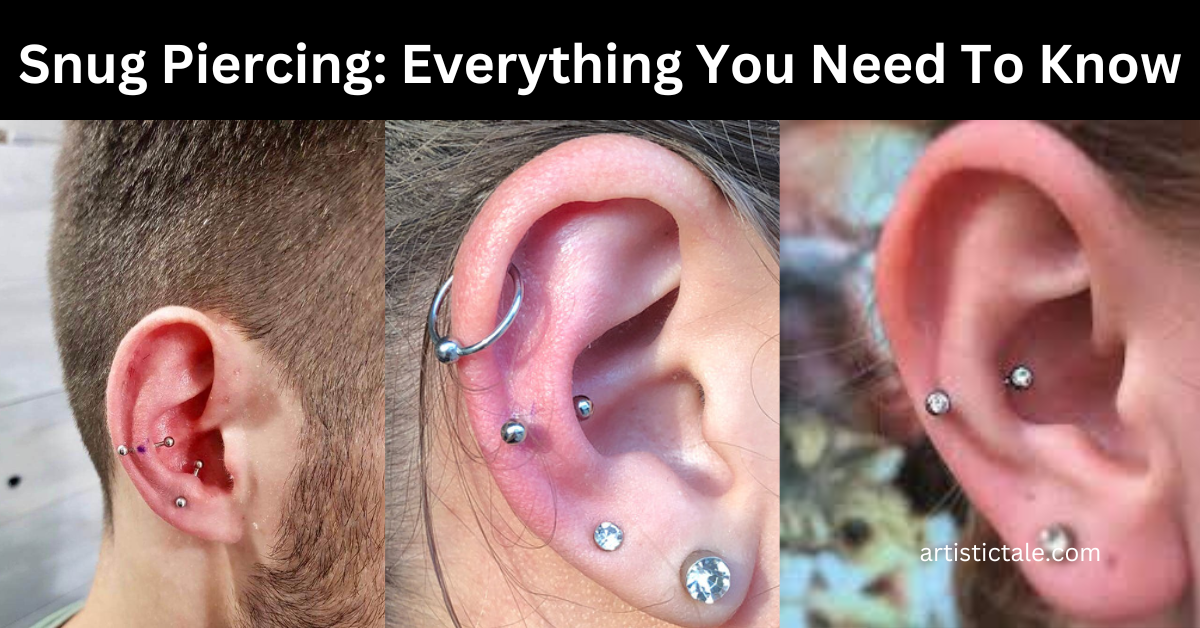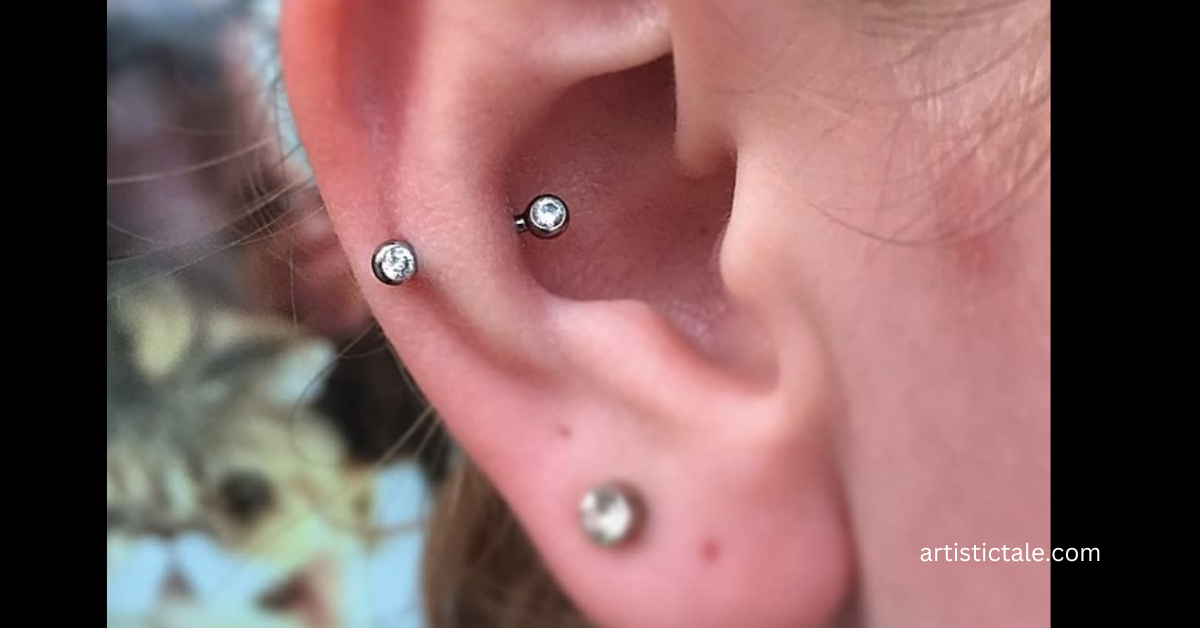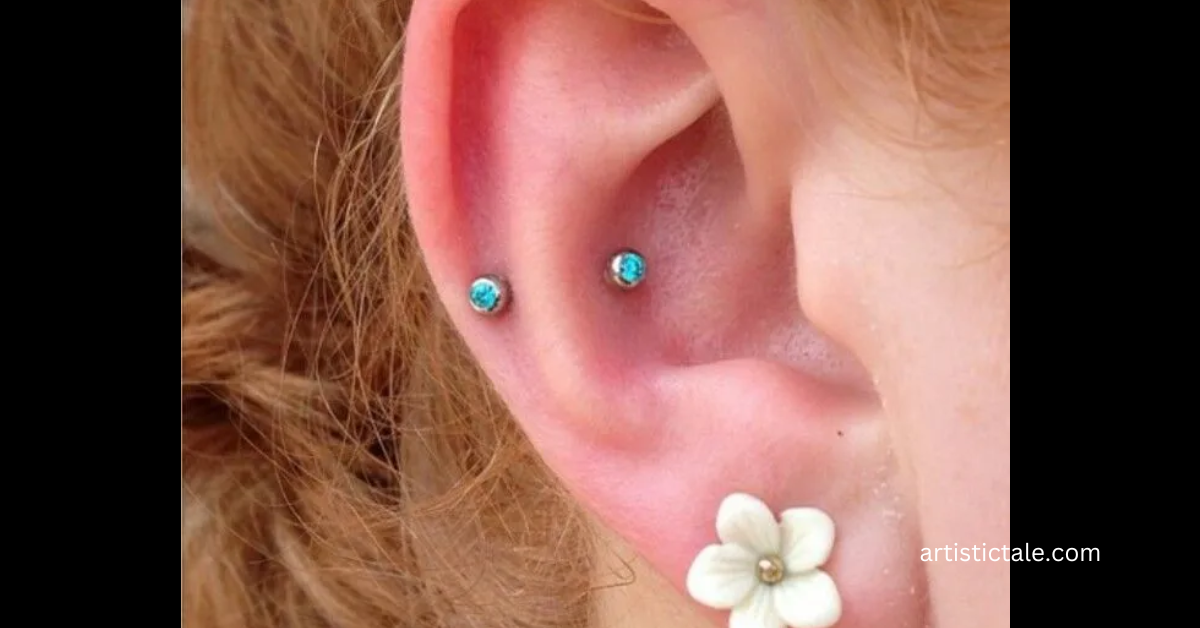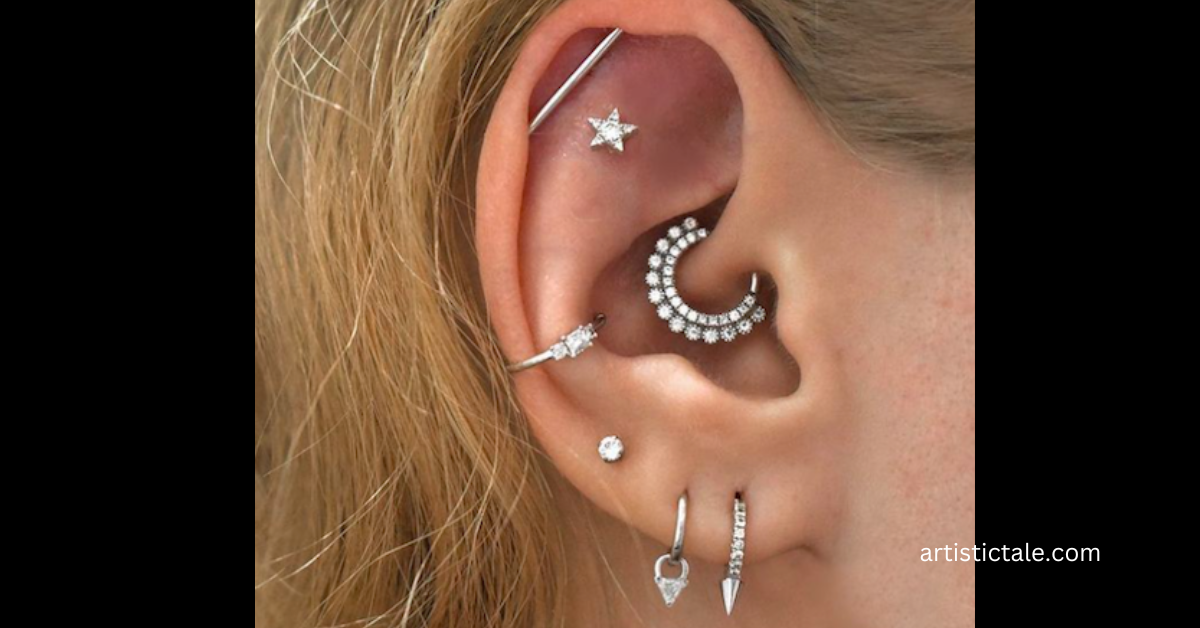Are you looking for an ear-piercing, ordinary, and yet interesting one? Snug Piercing is the right option for you. You can also have a wide selection of jewelry for snug piercings, so you can customize them however you like and always rock the piercing you like. If you’re thinking about getting a snug piercing, here’s everything you need to know about it.
Table of Contents
What Is A Snug Piercing?
A snug piercing is a horizontal piercing positioned just above the tragus antibody (or the inner ridge of the cartilaginous part of the ear). And the piercing is inserted through an area called the anti-helix that sits between the rim of the ear and the inner cartilage. A snug pericing is distinguished because its entry and exit points are visible from the front of the ear rather than from the back. However, there is one caveat to this form of piercing: it is not suitable for everyone’s ear. Before starting the procedure, double-check with your piercer to ensure that it is both comfortable and safe.
Snug Piercing Quick Facts
| The Placement | A horizontal piercing that is directly above the anti-tragus is referred to as a snug piercing (or the inner ridge of the cartilage part of the ear). |
| Pain | 4/10 only |
| Heal Time | 2 – 3 Weeks only |
| Snug Piercing Jewelry |
Jewelry for snug piercing is Curved Barbells – snug earrings
|
Snug Piercing Procedure
The piercing process is quite simple, although each piercer has his technique.
- Most often, the area is cleaned first with an alcohol swab usually.
- Then the piercer makes marks on the ear to make sure the client is happy with the placement.
- After the client has approved the mark, a curved disposable needle is pushed through, followed by snug jewelry.
Each piercing differs in technique, but they should always be pierced with a quality disposable needle, preferably lubricated for a smooth and fast piercing. They are usually pierced from the outside to the inside, using a freehand technique (without the use of instruments) and a curved barbell.
Cost Of Snug Ear Piercing
As with any piercing or body modification, the cost of a snug piercing will depend on the shop you choose and where in the world you are located. Unlike industrial piercings, snug piercings are frequently paid for as a single package, which includes both the process and the jewelry. If you opt to have your piercing done with something other than the usual “starting” jewelry, you will almost certainly be charged more. Some businesses may charge for aftercare, so be sure you know if you’ll need it ahead of time.
Every store will offer a different price; however, the cost usually depends on the jewelry you choose and the location of the store. The average cost in the United States is roughly $55, which includes everything except nursing care, which can be purchased for a few dollars almost anyplace. Many retailers charge for piercings, and the total price is determined by the jewelry you choose.”
Is Snug Piercing Hurtful?
Because the anti-helix cartilage is stiffer, piercing requires more force, resulting in more pain. Although some people feel more pain when the needle is pushed through (which takes one second or less) than when the jewelry is inserted, there is no way to know which stage of the piercing process will be the most painful. Sure, it hurts, but piercers claim that if it were so horrible, no one would choose to get their ears pierced.
As the days pass, the pain increases. It feels like bruising a toe, cutting paper, or biting our tongue. However, these injuries hurt equally. We handle them just fine because we don’t get time to be afraid of them because it happens as an accident. So why be afraid of getting a piercing that looks super cool? After All, they say beauty is pain.
Tips To Keep In Mind While Healing
Some believe snug piercings are not for the faint of heart as it is considered the most painful cartilage piercing. According to piercers, the snug piercing can take up to a year to heal, sometimes more, sometimes less.” However, the average time is around four to six months. Even then, because each body reacts differently to this process, You should prepare for this year-long period.
If no area of the piercing is tender anymore and there is no crusting around the piercing for two weeks, you can assume the piercing has healed fully. A snug piercing, on the other hand, is easily re-injured, so it’s critical to take good care of it even after it’s healed to avoid irritating it and restarting the healing process. Keep the following things in mind during the healing period:
- Keep the (curved) barbell into the piercing as it does not move, and it tends to speed up the healing process.
- Avoid touching the piercing again and again as you can transfer germs and bacteria to it, increasing the risk of infection.
- Do not attempt to change the piercing during this period. If it’s extremely important, then take professional help.
- Avoid eating tangy and sour food as it can increase swelling and redness.
- Do not sleep on the side with a piercing to avoid hurting it in your sleep.
- Follow aftercare routine religiously.
Snug Piercing Aftercare
A snug piercing will take four to six months to heal at the very least, so it’s crucial to monitor aftercare until it’s required. Aside from the piercing’s side effects, the ears themselves frequently have buildups of dead skin or other germs that can become lodged in the piercing if not properly cared for.
For at least three to four weeks, the site should be cleaned twice a day. To aid healing and prevent infection, apply mupirocin ointment (a topical antibiotic) to the affected region after cleansing. It’s crucial to talk with your piercer about what they recommend for the aftercare of a snug piercing because it’s not a sticking point. Some people suggest cleaning with hydrogen peroxide, while others suggest using unscented natural soap. Wash your piercing twice a day, and then apply the cleanser recommended by your piercer. To avoid bacterial infection, use a paper towel rather than a cloth to blot. Furthermore, when cleaning, be delicate and patient, and avoid using too much pressure.
Even if you clean a snug piercing properly, you should be aware that you will likely encounter symptoms that may concern you; yet, these are totally normal. For the first several days or weeks, expect swelling, redness, pain, and perhaps dull throbbing. They swell slightly more than other cartilage piercings, which can be uncomfortable for a while. To help with swelling, some piercers recommend applying aftercare piercing lotion.
The bumps on the cartilage are one of the signs to pay attention to. Some of these lumps are pustules, which are fluid-filled bumps; others are keloid scars, often known as thick scars, that occur at puncture sites. Unfortunately, when the cartilage is pierced, cartilage bumps are fairly common; proper follow-up will help you avoid these side effects, but they can also form if your ear is not ideal for a tight piercing, which is why it’s so crucial to talk to the piercer first.
If you leave your snug piercing alone for as long as possible, it will heal the best. To avoid inflammation, do not sleep on the ear with the piercing, and do not tug on it. You should also keep your piercing away from any bacteria-prone things, such as unclean bedding, headphones, headwear, or your phone. Avoid this piercing when you need to cover your ears, such as in the wintertime. Also, avoid turning or touching the jewelry when cleaning to avoid injury.
Snug Piercing Risks
You may experience pain for several days after the piercing, along with swelling, bleeding, redness, or discharge from the area. However, here are the risks associated with snug piercings to watch out for in order to signal something is wrong:
- Infection: As with any piercing, the main unwanted side effect is infection. If you see intense and persistent swelling, intense redness that persists, skin cracks, soreness, fluid buildup, or discharge around the piercing, it’s best to see a doctor right away. To treat an infected piercing, you usually only need to take an oral antibiotic after it has been confirmed by a professional.
- Pustule: A pus-filled blister or pimple, often caused by irritation of the piercing during healing. Continue to clean your piercing as directed, adding soak salt to your daily routine up to three times a day to flush out pustules safely.
- Keloid: A thick scar resulting from improper care during rehabilitation. Keloids are difficult to care for once they have formed and must either be removed or cared for in a way that reduces their appearance. Keloids can be surgically removed, or medication can be injected directly into the area to make it look less noticeable. However, if you choose to leave them alone, keloids will exist on your skin forever, so be sure to properly care for your piercing to avoid them in the first place.
- Rejection: This is the process by which your body thinks your new piercing is an unnatural threat and forces it out of your skin, healing the skin as it shifts so it can’t relocate. As with most piercings, the only way to get rid of rejection is to have the snug piercing professionally removed to speed up the process.
- Migration: Similar to rejection, this is when your body pushes around the piercing. However, migration occurs when your snug piercing moves but does not fully eject. This is rare with a snug piercing but is usually caused by improper care. If you notice this happening, talk to an experienced piercer about changing jewelry or other ways to move forward. Also, make sure you properly follow all recommended aftercare practices.
Final Lines…
Many professionals emphasize only getting this piercing if you can take care of it properly. But why not take some risks and enjoy the spark this piercing adds to our personality? We only live once; let’s do it without regrets. If you like it, go for it. But make sure you consult with a professional and know how to care for it afterward.
People Also Ask…
How to replace the snug piercing?
Take professional help to replace the piercing as they have the right tools and use the right techniques. It is recommended to change it only if it has healed completely.
What jewelry is used for a snug piercing?
You can use Curved Barbells or jingles.
What jewelry material is used for accurate piercing?
You can use titanium, gold, or surgical steel.
What is the most painful ear piercing?
The anti-tragus is one of the most sensitive positions you can get, scoring a 6-7/10 on the pain scale. This piercing takes around 6-12 months to fully heal.
What about snug piercing pain?
The snug piercing is believed to be the most painful ear piercing for the majority of people to get. In comparison to other piercings, it is about a 9/10 on the pain scale. However, keep in mind that even the most painful piercings will likely feel less than receiving a paper cut.



